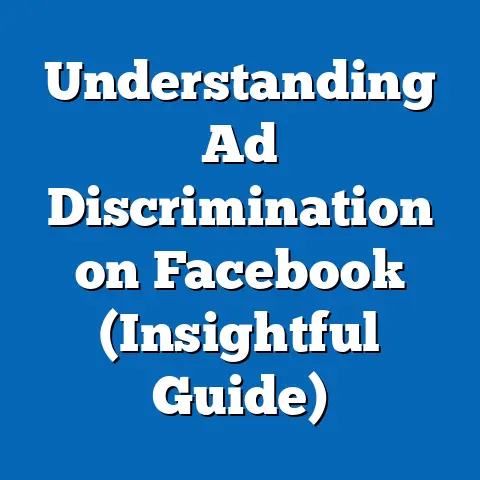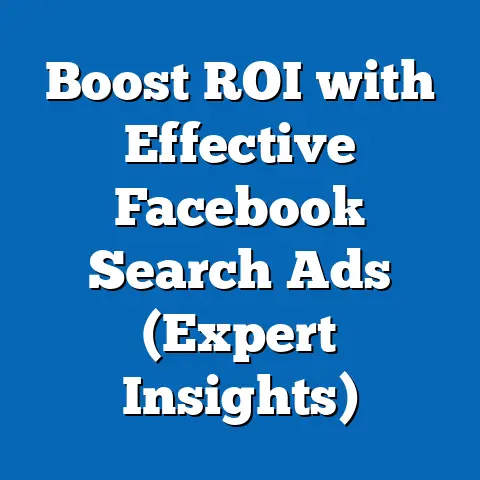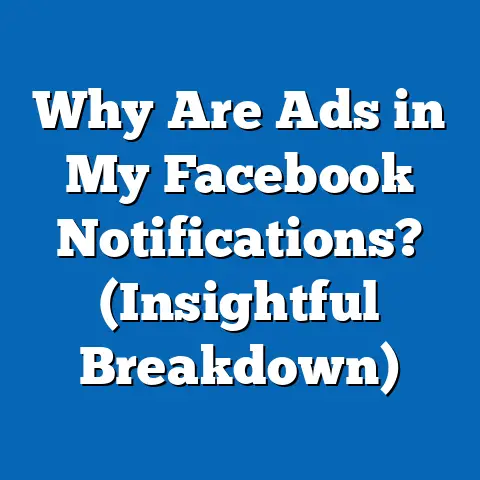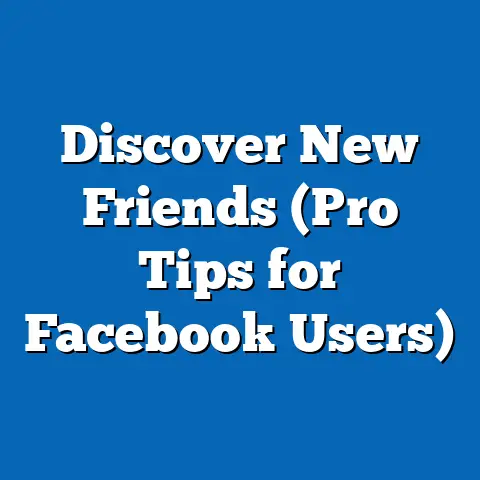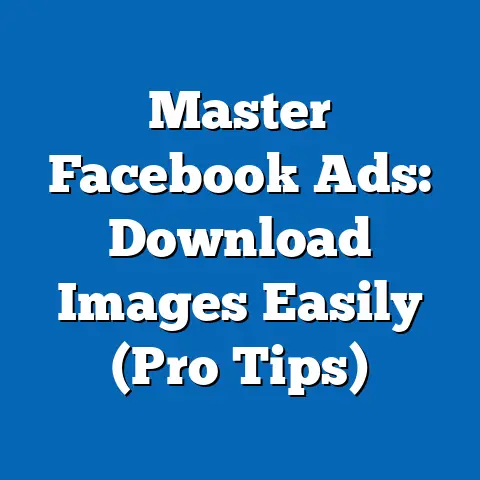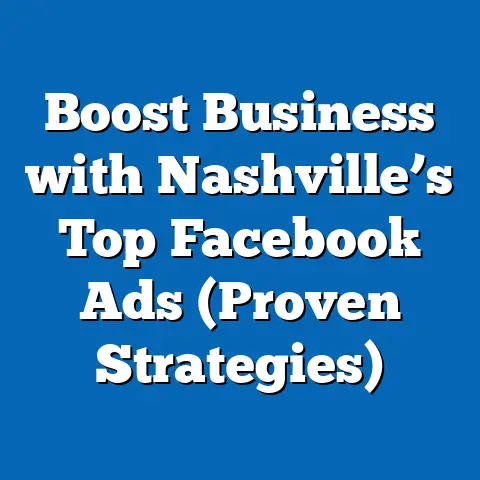Revitalize Facebook Ads: Transform Every 3 Posts (Smart Strategy)
Facebook advertising has become an integral part of digital marketing for businesses of all sizes. With billions of active users, Facebook offers an unparalleled opportunity to reach a vast and diverse audience. However, the landscape is constantly evolving, and what worked yesterday might not work today. To stay ahead of the competition, businesses need to continually innovate their ad strategies and find new ways to engage their target audience. This is where the “Transform Every 3 Posts” strategy comes into play.
In this article, I’ll guide you through a smart and effective approach to revitalizing your Facebook ads. This strategy focuses on understanding room-specific needs, crafting engaging content, leveraging Facebook’s ad tools, and continuously analyzing and adjusting your tactics. I’ll break down complex concepts into actionable steps, providing you with the knowledge and tools you need to transform your Facebook ad campaigns and achieve your business goals. I will also share my personal experiences, unique insights related to the topic to make it stand out.
Whether you’re a seasoned marketer or just starting out with Facebook advertising, this guide will provide you with valuable insights and practical tips to take your campaigns to the next level. Let’s dive in and explore how you can revitalize your Facebook ads by transforming every 3 posts!
Section 1: Understanding Room-Specific Needs
Before diving into specific strategies, it’s crucial to understand what I mean by “room-specific needs” in the context of Facebook Ads. Think of your business as a room in a house. Each room has a different function, decor, and atmosphere. Similarly, different industries have unique advertising requirements and target audiences. What works for a fashion brand might not work for a technology company, and vice versa.
Understanding these room-specific needs is essential for creating effective Facebook ad campaigns that resonate with your target audience and drive results. It’s about tailoring your messaging, visuals, and targeting to the specific preferences, behaviors, and pain points of your ideal customer.
Defining Room-Specific Needs
Room-specific needs refer to the unique advertising requirements and target audience characteristics that are specific to different industries and business types. These needs can include:
- Target audience demographics and psychographics: Understanding the age, gender, location, interests, and values of your ideal customer.
- Industry-specific trends and challenges: Staying up-to-date with the latest trends and challenges in your industry and addressing them in your advertising.
- Competitive landscape: Analyzing your competitors’ advertising strategies and identifying opportunities to differentiate yourself.
- Product or service characteristics: Highlighting the unique features and benefits of your product or service that appeal to your target audience.
- Brand voice and messaging: Creating a consistent brand voice and messaging that resonates with your target audience and reflects your brand values.
Industry-Specific Examples
Let’s take a look at some examples of how room-specific needs can vary across different industries:
- Fashion: Fashion brands often focus on visual appeal, showcasing their latest collections and trends through high-quality images and videos. They may also use influencer marketing and target fashion-conscious consumers with specific interests and style preferences.
- Technology: Technology companies often emphasize innovation, functionality, and problem-solving in their advertising. They may use explainer videos, product demos, and case studies to showcase the benefits of their products and target tech-savvy consumers with specific needs and interests.
- Food & Beverage: Food and beverage companies often focus on sensory appeal, showcasing their products through mouth-watering images and videos. They may also use recipes, cooking tips, and user-generated content to engage their target audience and target foodies with specific dietary preferences and interests.
- Fitness: Fitness brands often focus on health, wellness, and motivation in their advertising. They may use before-and-after photos, workout videos, and testimonials to showcase the benefits of their programs and target health-conscious consumers with specific fitness goals and interests.
Case Studies of Success
Many businesses have successfully identified and addressed their specific needs through Facebook advertising. Here are a few examples:
- Daniel Wellington: The watch brand Daniel Wellington built its brand on Facebook and Instagram by carefully targeting fashion-conscious consumers with minimalist designs and a consistent aesthetic. They used influencer marketing and user-generated content to build trust and credibility and drive sales.
- Dollar Shave Club: The razor subscription service Dollar Shave Club gained widespread recognition with its humorous and relatable video ads that addressed the pain points of shaving. They used targeted advertising to reach men with specific shaving needs and preferences and disrupted the traditional razor market.
- HelloFresh: The meal kit delivery service HelloFresh uses targeted advertising to reach busy professionals and families who are looking for convenient and healthy meal options. They use mouth-watering images and videos of their meals, as well as recipes and cooking tips, to engage their target audience and drive subscriptions.
Understanding Your Target Audience
Understanding your target audience’s behavior, preferences, and pain points is crucial for shaping your ad content and strategy. This involves conducting thorough research and analysis to gain insights into your ideal customer. Here are some methods you can use:
- Surveys and questionnaires: Collect data directly from your target audience by asking them about their needs, preferences, and pain points.
- Focus groups: Conduct focus groups to gather qualitative data and gain deeper insights into your target audience’s motivations and attitudes.
- Social media listening: Monitor social media conversations and trends to understand what your target audience is talking about and what they care about.
- Website analytics: Analyze your website traffic and user behavior to understand how your target audience interacts with your website and content.
- Customer feedback: Collect feedback from your existing customers to understand their experiences with your product or service and identify areas for improvement.
Segmentation and Audience Personas
Segmentation involves dividing your target audience into smaller groups based on shared characteristics, such as demographics, interests, and behaviors. Creating audience personas involves developing fictional representations of your ideal customers based on your research and analysis.
By segmenting your audience and creating audience personas, you can tailor your ad content and targeting to the specific needs and preferences of each group. This can lead to higher engagement rates, lower ad costs, and better overall results.
Takeaway: Understanding room-specific needs is the foundation of effective Facebook advertising. By identifying the unique requirements and target audience characteristics of your industry, you can create more relevant and engaging ad campaigns that drive results.
Section 2: The “Transform Every 3 Posts” Strategy
Now that we’ve discussed the importance of understanding room-specific needs, let’s dive into the core concept of the “Transform Every 3 Posts” strategy. This strategy is a simple yet effective way to prevent ad fatigue, keep your audience engaged, and optimize your Facebook ad campaigns for better results.
The basic idea behind the “Transform Every 3 Posts” strategy is to rotate the type of content you’re sharing in your ads. Instead of constantly bombarding your audience with promotional messages, you’ll alternate between different types of posts, such as promotional, educational, and engagement-focused.
The Significance of Content Rotation
Content rotation is crucial for preventing ad fatigue among users. Ad fatigue occurs when users become overexposed to the same ads, leading to decreased engagement and higher ad costs. By rotating your content, you can keep your ads fresh and engaging, preventing ad fatigue and improving your overall campaign performance.
I’ve seen so many businesses make the mistake of running the same ad for weeks or even months on end. While it might seem like a cost-effective approach, it can actually be detrimental to your campaign performance. Users will start to tune out your ads, and your engagement rates will plummet.
Types of Posts to Transform
The “Transform Every 3 Posts” strategy involves rotating between three main types of posts:
- Promotional: These posts are designed to directly promote your products or services. They should include a clear call to action and highlight the benefits of your offering.
- Educational: These posts provide valuable information and insights to your target audience. They should be relevant to your industry and address the pain points of your ideal customer.
- Engagement-Focused: These posts are designed to spark conversation and encourage interaction with your audience. They can include questions, polls, contests, or behind-the-scenes content.
By rotating between these three types of posts, you can create a well-rounded ad campaign that keeps your audience engaged and drives results.
Creating a Content Calendar
To implement the “Transform Every 3 Posts” strategy effectively, it’s helpful to create a content calendar. A content calendar is a schedule that outlines the types of posts you’ll be sharing and when you’ll be sharing them.
Here’s an example of a content calendar for the “Transform Every 3 Posts” strategy:
- Day 1: Promotional Post
- Day 2: Promotional Post
- Day 3: Promotional Post
- Day 4: Educational Post
- Day 5: Educational Post
- Day 6: Educational Post
- Day 7: Engagement-Focused Post
- Day 8: Engagement-Focused Post
- Day 9: Engagement-Focused Post
- Day 10: Promotional Post …and so on.
You can customize this content calendar to fit your specific needs and goals. The key is to maintain a consistent rotation between the three types of posts.
Measuring Effectiveness
It’s essential to measure the effectiveness of each type of post and make data-driven decisions for future campaigns. You can track key metrics such as:
- Click-Through Rate (CTR): The percentage of users who click on your ad after seeing it.
- Conversion Rate: The percentage of users who take a desired action after clicking on your ad, such as making a purchase or filling out a form.
- Engagement Rate: The percentage of users who interact with your ad, such as liking, commenting, or sharing.
- Cost Per Click (CPC): The amount you pay each time a user clicks on your ad.
- Cost Per Conversion (CPC): The amount you pay each time a user takes a desired action after clicking on your ad.
By tracking these metrics, you can identify which types of posts are performing best and optimize your campaigns accordingly. For example, if you notice that your educational posts are generating high engagement rates but low conversion rates, you might want to adjust your call to action or targeting to improve conversions.
Takeaway: The “Transform Every 3 Posts” strategy is a simple yet effective way to prevent ad fatigue, keep your audience engaged, and optimize your Facebook ad campaigns for better results. By rotating between promotional, educational, and engagement-focused posts, you can create a well-rounded ad campaign that drives results.
Section 3: Crafting Engaging Content
Creating compelling ad content is essential for capturing the attention of your target audience and driving results. In this section, I’ll share some tips for crafting engaging content that resonates with your audience and enhances ad performance.
The Importance of Visual Elements
Visual elements, such as images and videos, play a crucial role in capturing the attention of your target audience. In fact, studies have shown that visual content is processed 60,000 times faster in the brain than text.
When creating visual content for your Facebook ads, it’s important to:
- Use high-quality images and videos: Avoid using blurry or pixelated images.
- Choose visuals that are relevant to your message: Make sure your visuals are consistent with the content of your ad.
- Use eye-catching colors and designs: Use colors and designs that grab attention and stand out from the crowd.
- Optimize your visuals for mobile: Most Facebook users access the platform on their mobile devices, so it’s important to optimize your visuals for mobile viewing.
Copywriting Tips
Copywriting is the art of writing persuasive and engaging text that motivates your target audience to take action. When writing copy for your Facebook ads, it’s important to:
- Know your audience: Understand their needs, preferences, and pain points.
- Write clear and concise copy: Avoid using jargon or overly complex language.
- Highlight the benefits of your offering: Focus on what your audience will gain by using your product or service.
- Use strong calls to action: Tell your audience exactly what you want them to do, such as “Shop Now” or “Learn More.”
- A/B test different copy variations: Experiment with different headlines, descriptions, and calls to action to see what works best.
Utilizing Storytelling Techniques
Storytelling is a powerful way to make your ads more relatable and engaging. By sharing stories about your brand, your customers, or your products, you can connect with your audience on an emotional level and build trust and credibility.
When using storytelling techniques in your Facebook ads, it’s important to:
- Keep it authentic: Share stories that are genuine and relatable.
- Focus on the human element: Highlight the people behind your brand or the customers who have benefited from your products.
- Use vivid language and imagery: Paint a picture with your words and visuals.
- Create a sense of conflict and resolution: Share stories that have a clear beginning, middle, and end.
- End with a call to action: Encourage your audience to take action after hearing your story.
User-Generated Content and Testimonials
User-generated content (UGC) and testimonials are powerful ways to build trust and credibility with your target audience. UGC refers to content created by your customers, such as photos, videos, and reviews. Testimonials are written statements from satisfied customers that highlight the benefits of your product or service.
When using UGC and testimonials in your Facebook ads, it’s important to:
- Get permission from the creators: Make sure you have the right to use the content in your ads.
- Choose high-quality content: Select content that is visually appealing and well-written.
- Highlight the benefits of your product or service: Choose UGC and testimonials that showcase the value of your offering.
- Use real names and photos: This will make the content more credible and relatable.
- A/B test different UGC and testimonials: Experiment with different content variations to see what works best.
A/B Testing
A/B testing involves creating two or more versions of your ad and testing them against each other to see which one performs best. This is a crucial step in optimizing your Facebook ad campaigns for maximum results.
When A/B testing your Facebook ads, it’s important to:
- Test one element at a time: This will allow you to isolate the impact of each change.
- Choose a clear metric to measure: This could be click-through rate, conversion rate, or engagement rate.
- Run your tests for a sufficient amount of time: This will ensure that you have enough data to draw meaningful conclusions.
- Analyze your results and make data-driven decisions: Use the data you collect to optimize your campaigns and improve your results.
Takeaway: Crafting engaging content is essential for capturing the attention of your target audience and driving results. By using high-quality visuals, writing clear and concise copy, utilizing storytelling techniques, and incorporating user-generated content and testimonials, you can create Facebook ads that resonate with your audience and achieve your business goals.
Section 4: Leveraging Facebook’s Ad Tools
Facebook offers a wide range of advertising tools and features that can support the “Transform Every 3 Posts” strategy and help you optimize your campaigns for better results. In this section, I’ll provide an overview of some of the most important tools and features and explain how you can use them to your advantage.
Facebook Insights and Ads Manager
Facebook Insights and Ads Manager are two critical tools for tracking performance and audience engagement. Facebook Insights provides data on your audience demographics, interests, and behaviors, while Ads Manager allows you to create and manage your ad campaigns.
By using these tools, you can:
- Track the performance of your ads: Monitor key metrics such as click-through rate, conversion rate, and engagement rate.
- Understand your audience: Learn more about their demographics, interests, and behaviors.
- Optimize your campaigns: Make data-driven decisions to improve your results.
- Target the right audience: Reach the people who are most likely to be interested in your products or services.
- Manage your budget: Control your ad spend and maximize your ROI.
Advanced Targeting Options
Facebook offers a wide range of advanced targeting options that allow you to reach specific audiences based on their demographics, interests, behaviors, and connections. Some of the most popular targeting options include:
- Demographic Targeting: Target users based on their age, gender, location, education, and other demographic characteristics.
- Interest Targeting: Target users based on their interests, hobbies, and passions.
- Behavior Targeting: Target users based on their online behavior, such as their purchase history, website visits, and app usage.
- Lookalike Audiences: Create audiences that are similar to your existing customers or website visitors.
- Retargeting: Target users who have previously interacted with your website or Facebook page.
By using these advanced targeting options, you can reach the people who are most likely to be interested in your products or services and improve your ad performance.
Facebook Pixel
The Facebook Pixel is a piece of code that you can install on your website to track conversions and optimize your campaigns. By tracking conversions, you can see which ads are driving the most sales or leads and make data-driven decisions to improve your ROI.
The Facebook Pixel allows you to:
- Track conversions: See which ads are driving the most sales or leads.
- Optimize your campaigns: Make data-driven decisions to improve your ROI.
- Create custom audiences: Target users who have taken specific actions on your website, such as visiting a certain page or adding an item to their cart.
- Retarget users: Target users who have previously visited your website but haven’t yet made a purchase.
Budgeting and Bidding Strategies
Budgeting and bidding strategies are crucial for maximizing ROI on your Facebook ads. Facebook offers a variety of budgeting and bidding options, including:
- Daily Budget: Set a daily budget for your ad campaign.
- Lifetime Budget: Set a lifetime budget for your ad campaign.
- Automatic Bidding: Let Facebook automatically bid on your ads to get the best results.
- Manual Bidding: Set your own bids for your ads.
When choosing a budgeting and bidding strategy, it’s important to consider your goals, your budget, and your target audience. You should also experiment with different strategies to see what works best for your business.
Takeaway: Leveraging Facebook’s ad tools is essential for optimizing your campaigns and achieving your business goals. By using Facebook Insights and Ads Manager, advanced targeting options, the Facebook Pixel, and strategic budgeting and bidding strategies, you can maximize your ROI on Facebook ads.
Section 5: Analyzing and Adjusting Strategies
Continuous analysis and adjustment are crucial in Facebook advertising campaigns. The digital landscape is constantly evolving, and what worked yesterday might not work today. To stay ahead of the curve, you need to continuously monitor your campaign performance, analyze the data, and make adjustments to your strategy as needed.
Key Performance Indicators (KPIs)
Key Performance Indicators (KPIs) are metrics that businesses should monitor to track the success of their Facebook advertising campaigns. Some of the most important KPIs include:
- Click-Through Rate (CTR): The percentage of users who click on your ad after seeing it. A high CTR indicates that your ad is relevant and engaging to your target audience.
- Conversion Rate: The percentage of users who take a desired action after clicking on your ad, such as making a purchase or filling out a form. A high conversion rate indicates that your ad is effectively driving results.
- Engagement Rate: The percentage of users who interact with your ad, such as liking, commenting, or sharing. A high engagement rate indicates that your ad is resonating with your audience and sparking conversation.
- Cost Per Click (CPC): The amount you pay each time a user clicks on your ad. A low CPC indicates that your ad is efficiently reaching your target audience.
- Cost Per Conversion (CPC): The amount you pay each time a user takes a desired action after clicking on your ad. A low CPC indicates that your ad is effectively driving results at a reasonable cost.
- Return on Ad Spend (ROAS): The amount of revenue you generate for every dollar you spend on advertising. A high ROAS indicates that your ad campaigns are profitable.
By monitoring these KPIs, you can gain valuable insights into the performance of your Facebook advertising campaigns and identify areas for improvement.
Interpreting Data and Making Adjustments
Interpreting data is a crucial step in optimizing your Facebook advertising campaigns. By analyzing your KPIs, you can identify which ads are performing well and which ones are not. You can then make adjustments to your strategy based on the data you’ve collected.
For example, if you notice that your CTR is low, you might want to try:
- Improving your ad copy: Write more compelling and relevant copy that grabs attention.
- Using more eye-catching visuals: Choose images and videos that stand out from the crowd.
- Targeting a different audience: Reach a more relevant audience that is more likely to be interested in your products or services.
If you notice that your conversion rate is low, you might want to try:
- Improving your landing page: Make sure your landing page is relevant to your ad and provides a clear and compelling call to action.
- Simplifying the checkout process: Make it easy for users to make a purchase.
- Offering incentives: Offer discounts, free shipping, or other incentives to encourage users to convert.
Feedback Loops from Audience Interactions
Feedback loops from audience interactions can provide valuable insights into how your ads are resonating with your target audience. By monitoring comments, likes, shares, and other interactions, you can gain a better understanding of what your audience is thinking and feeling about your ads.
This feedback can inform future content creation and ad transformations. For example, if you notice that users are frequently asking questions about a particular product feature, you might want to create an educational post that addresses those questions. If you notice that users are sharing positive reviews of your product, you might want to use those reviews in your ads.
Staying Updated with Facebook’s Evolving Ad Landscape
Facebook’s ad landscape is constantly evolving, with new features, tools, and best practices being introduced regularly. To stay ahead of the curve, it’s important to stay updated with the latest changes and adapt your strategies accordingly.
You can stay updated by:
- Following the Facebook Business blog: The Facebook Business blog provides updates on new features, tools, and best practices.
- Attending industry conferences and webinars: Industry conferences and webinars provide valuable insights into the latest trends and strategies in Facebook advertising.
- Networking with other marketers: Networking with other marketers can provide valuable insights and perspectives on Facebook advertising.
- Experimenting with new features and tools: Don’t be afraid to try out new features and tools to see how they can improve your campaign performance.
Takeaway: Continuous analysis and adjustment are crucial in Facebook advertising campaigns. By monitoring your KPIs, interpreting the data, utilizing feedback loops from audience interactions, and staying updated with Facebook’s evolving ad landscape, you can optimize your campaigns for maximum results.
Conclusion
In conclusion, revitalizing your Facebook Ads through a structured approach that addresses room-specific needs is essential for success in today’s digital marketing landscape. By understanding the unique requirements and target audience characteristics of your industry, you can create more relevant and engaging ad campaigns that drive results.
The “Transform Every 3 Posts” strategy is a simple yet effective way to prevent ad fatigue, keep your audience engaged, and optimize your Facebook ad campaigns for better results. By rotating between promotional, educational, and engagement-focused posts, you can create a well-rounded ad campaign that drives results.
Leveraging Facebook’s ad tools is also crucial for optimizing your campaigns and achieving your business goals. By using Facebook Insights and Ads Manager, advanced targeting options, the Facebook Pixel, and strategic budgeting and bidding strategies, you can maximize your ROI on Facebook ads.
Finally, continuous analysis and adjustment are essential in Facebook advertising campaigns. By monitoring your KPIs, interpreting the data, utilizing feedback loops from audience interactions, and staying updated with Facebook’s evolving ad landscape, you can optimize your campaigns for maximum results.
I encourage you to implement these strategies and share your experiences in revitalizing your Facebook ad campaigns. By continuously innovating and adapting your strategies, you can stay ahead of the competition and achieve your business goals.

